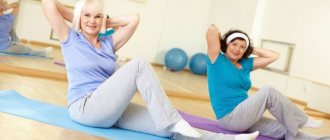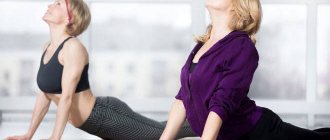Is it possible to do exercises before bed?
Evening is a time to rest and prepare for bed. Isn’t it harmful to exercise at this time of day, when you have no strength for anything? Tension in the muscles, accumulated during the day, makes any body movements difficult and unbearable. Even emotional fatigue affects physical performance during the day, not to mention the daily stress that almost everyone faces.
All these factors not only accumulate fatigue, but also affect sleep and sleep patterns, complicate the process of wakefulness, and lead to chronic fatigue, which is more difficult to combat every day. The easiest way to help yourself is to perform a simple set of evening exercises. Relieving the nervous system and relaxing the muscles for good sleep will help you fall asleep and wake up with ease, recover faster during the night, and improve your overall physical condition during the day.
Features of gymnastics before bedtime
- Exercising before bed in evening exercises does not lead to muscle overstrain and excessive contraction. On the contrary, exercises are aimed at relieving fatigue, and proper tension will create slight fatigue for better sleep.
- A complex of such gymnastics is suitable for women and men, as well as children and the elderly, the main thing is to choose the appropriate level of load.
- For weight loss, a complex of evening exercises is not as effective as a full-fledged workout, but it still helps speed up metabolism and tone muscles, which will have a positive effect on reducing body volume.
Also read: A set of exercises for weight loss for women → A set of exercises for weight loss for men →
Breathing exercises before bed
It may seem to many that there is no relationship between breathing and healthy sleep. But the brain, tired during the day, experiencing significant overload, suffers from a lack of oxygen, which leads to overexcitation of the body and prolonged falling asleep. And as you know, one of the components of a quality night's rest is an even emotional state. To normalize sleep, doctors advise regularly performing special breathing exercises. A person who is fluent in these techniques is able not only to control his health and mood, but also to completely relax the nervous system.
People suffering from insomnia are recommended to master sleep exercises aimed at training the correct breathing rhythm, normalizing the process of falling asleep, and restoring general psycho-emotional balance. In the East, the birthplace of many ancient practices, including Tibetan ones, great attention is still paid to these exercises to this day. It is not for nothing that entire healing systems are created on their basis, using the principles of proper breathing.
These techniques are well mastered by divers who have minimal equipment in their arsenal. They are able to hold their breath for long periods. People involved in diving are also trained under this program.
Purpose and contraindications
The condition of the body depends on the frequency and depth of breaths, the duration of air retention in the lungs. It has been proven that if you breathe frequently and shallowly, the desired effect will not be achieved; on the contrary, additional stimulation will occur, and the nervous system will activate its activity. Gymnastics for sleep, the goal of which is to achieve maximum relaxation, is based on measured and deep breathing, and is subject to a strict rhythm. Any breathing exercise for sleep has an effective effect on the body in the following ways:
- ensures maximum filling of the lungs with air, promoting their expansion;
- enriches tissue cells with oxygen;
- eliminates muscle spasm, relieving pain;
- restores blood pressure;
- activates work and improves blood supply to the brain;
- normalizes the activity of the nervous system, facilitating the process of falling asleep;
- strengthens the immune system, helps get rid of chronic respiratory diseases.
By regularly performing exercises and alternating different techniques, you can quickly achieve positive results. But, despite all the obvious benefits and safety of these methods, doctors recommend in special cases limiting or not starting their use at all. This applies to people who have:
- severe infectious lesions;
- acute or chronic respiratory diseases (asthma, obstructive bronchitis);
- old age.
Gymnastics should not be used in cases of insomnia caused by serious reasons, which cannot be overcome with exercises alone. Therefore, in order to maintain your health and choose the best option for getting rid of insomnia, you need to consult with your doctor.
Known techniques
Familiarization with proper breathing techniques should take place under the guidance of a professional, but if this is not possible, you should begin to put into practice elementary exercises that you can perform independently at home. Their ease and accessibility makes it possible to use these techniques in health centers and even in kindergartens, in particular, in the middle and senior groups. To get rid of insomnia, you need to concentrate on your own feelings, which allows you to escape from unpleasant thoughts, worries and anxieties. The breathing techniques presented below will help restore inner harmony and calm, prepare the body and brain for proper rest.
Breathing to the count of “10”
- Take a horizontal position.
- Count to ten, odd numbers - inhale, even numbers - exhale.
- Perform 2-3 cycles, inhaling air through your mouth.
Alternative breathing through the nose
- Sit comfortably on a chair with your back straight.
- Close your right nostril with your finger and inhale slowly through the free one.
- Release the closed passage and exhale air through it.
- Start the next cycle by clamping the left channel.
- Repeat 2-3 cycles.
Square breathing
- All manipulations are performed on the account “1-2-3-4”.
- Inhale or release air within four seconds.
- You must hold your breath in your lungs for the same amount of time, and after exhaling, do not breathe.
Breathing with delay
Use different variations of the delay of the inhale-exhale-pause cycle. The most acceptable ratio is 8-4-8-4. With practice, you can change the execution time of each element.
Breathing exercises according to Komarovsky
The newly developed complex helps restore emotional balance and cleanse the lungs and bronchi. Its implementation involves breathing calmly through the nose and then through the mouth. You should take 15 inhalations and exhalations with a five-second break. Then you need to breathe steadily only through the nasal passage, while raising and lowering your arms.
Preparatory stage
To achieve high efficiency from breathing exercises, you need to prepare properly and strictly follow all the recommendations.
The optimal time for classes is the evening hours before bedtime.
- Thoroughly ventilate the room and leave a window or transom open to provide fresh air.
- Wear comfortable, loose clothing that does not restrict movement. It should be made from natural fabrics.
- Relax not only physically, but also emotionally - get rid of unpleasant or disturbing thoughts.
- Sit comfortably in bed, taking the correct position.
It is better to perform breathing exercises to normalize sleep with your eyes turned off and in a good mood - this promotes maximum relaxation and speeds up the process of falling asleep. You should start with simple exercises, gradually increasing the number of repetitions. You are allowed to breathe at a slow pace and only through the nose, and you need to make sure that the exhalation is longer than the inhalation. During training, you need to listen to your feelings. If the slightest discomfort, tension or fatigue appears, the process should be interrupted.
Simple and effective exercises and techniques for performing them
To master the simplest techniques, you need to understand how the breathing process occurs, and first get acquainted and experiment with three basic techniques.
Diaphragmatic. Breathing is based on the compression and expansion of the diaphragm and is performed only with the stomach. At first, the process should be controlled, so the palm of one hand should be placed in the area above the navel, and the other on the sternum. Slowly inhale deeply through the nose, filling the abdominal cavity with air. The chest should remain motionless. Stay in this position for a few seconds, then release it from yourself at the same rhythm, trying to contract your abdominal muscles as much as possible. The exercise should be performed smoothly and easily, without effort.
Costal A similar technique, only the chest and ribs are involved in the process, while the stomach remains motionless. It is not always possible to perform it correctly the first time, but after several lessons, it will become quite accessible. In everyday life, this type of breathing is considered superficial, since oxygen enters the body in limited quantities.
Clavicular. The starting position remains the same, but the task becomes much more complicated. When inhaling, the flow should be directed to the upper lungs and bronchi. The chest and abdomen should remain motionless. This type of breathing is recommended for people suffering from asthma.
Having mastered these techniques and applied them in practice, you can begin to study an exercise that allows you to completely relax the body through full breathing. To do this, you need to lie on your back and exhale deeply. Inhale at a slow pace only through the stomach. As the abdominal cavity increases, air should penetrate into the chest and then into the subclavian region. Having filled the entire space as much as possible, you should also smoothly release the stream, but in the reverse descending order.
Final stage
All exercises should be performed easily, effortlessly, without straining. You need to finish classes gradually, smoothly transitioning to sleep. Breathing should be smooth, mood should be good, and state should be calm. It is not recommended to start watching programs or communicating on social networks. It is better to drink a cup of lemon balm (mint) tea or warm milk, take a comfortable position and fall asleep.
What is the “4-7-8” technique
The breathing technique for sleep was developed by Andrew Weil, MD, based on the ancient Indian practice of pranayama. It is a special complex and is carried out to eliminate sleep disorders, combat anxiety and stress. The course of classes is two months with twice daily training.
The main requirements of the “4-7-8” technique are the absence of air in the lungs, tightly clenched teeth, to which the tip of the tongue is pressed. The exercise begins with a deep nasal inhalation counting 1-2-3-4. After this, you should hold your breath (5-6-7). Next, a slow exhalation occurs (8-7-6-5-4-3-2-1), while the mouth should be slightly open, and the tongue should also be pressed firmly to the teeth.
On the first day, you should perform 2 approaches, and then increase their number by one every day. The maximum number of repetitions is 8. After this, you need to gradually reduce this figure to 2.
Warm-up
Exercises are performed for 30 seconds.
Tilts and turns of the head
Perform simple head tilts to the sides for 30 seconds, without raising your shoulders. Gently stretch the sides of your neck muscles. Then turn your head slowly to the sides, do not make sudden movements. Do not twist your neck too much, feel the stretching of the muscles.
Circular movements with hands
Standing straight, perform circular movements with your arms in one direction, then in the opposite direction. Do not swing when moving your arms. Do not round your back and do not help with your spine and shoulder blades. Movement occurs only in the shoulder joints.
Knee lift or running in place
For beginners , you can perform a simple version by raising your knees up one at a time, your hips should reach a horizontal position. More advanced ones can perform quick climbs, simulating running in place.
Recommended exercises before bed
In order to get into the right frame of mind at night after an active working day, you need to perform special exercises before going to bed. They are aimed, as a rule, at calming, putting thoughts in order and smoothly stretching the muscles. All movements should be slow, you should not hold your breath and allow discomfort when performing.
- To improve sleep, it is very important to start exercises with breathing exercises. You should sit straight, cross-legged, and try to stretch your spine. You need to breathe deeply and smoothly through your nose. Inhalations and exhalations should be slow, this will help saturate the body with oxygen, and if your head starts to hurt at the end of the day, such breathing exercises will ease the pain. During this exercise, try to discard all anxious thoughts and relax your arms and legs.
- While in the same position, it is useful to perform gentle tilts of the head to the sides, and then circular movements with the head. The cervical spine takes on an extremely heavy load during the day, so these simple exercises are extremely important for the prevention of osteochondrosis. If your job involves sitting for long periods of time, it is advisable to perform this exercise several times throughout the day.
- During the second exercise, you need to sit down with your legs stretched forward. While inhaling, the body is tilted. If you can't keep your legs straight, they can be slightly bent, but your stomach should rest on your hips. Inhaling, we try to stretch forward, and exhaling, we try to straighten our legs a little. It is very important to avoid sudden movements, as you can strain the lower back, which should be as relaxed as possible when performing the exercise.
- After bending, it is necessary to compensate for possible tension in the back. To do this, sit on your heels, feet together, knees slightly apart, tilt your body forward and place your head on the floor. Take a few deep breaths and relax.
- After a hard day, you need to pay special attention to your spine. A great exercise for this is crunching. You need to sit cross-legged, place your right hand on your left knee, place your left hand behind your back, and look behind your left shoulder. Very slowly and gently with each exhalation, pushing off the knee with our right hand, we twist ourselves to the left. After which you need to carefully unwind and repeat the same thing to the right side.
- We spend the whole day in a horizontal position, which puts stress on our legs. The following exercise will help relieve this tension. To do this, you need to lie down, moving your pelvis towards the wall, and stretch your legs up along the wall. The arms lie relaxed next to the body, the tension slowly disappears from the feet, legs, knees, and hips.
- Dynamic rolls will allow you to relax your back. In a lying position, you need to clasp your knees with your hands and do several rolls to the sides and back and forth.
- The following exercise will be very useful for the lumbar spine. You need to lie on your back, spread your arms to the sides on the floor, place your right foot on your left knee, and try to reach the floor with your right knee. In this case, the right hand should not leave the floor. Repeat on the other side.
Main part
Exercises are performed for 1 minute.
Squats
Place your feet hip-width apart, with your feet parallel. When squatting, make sure that your knees do not form an acute angle. The lowest point of the movement is reached at the moment when the hips are in a horizontal position. Don't put your center of gravity on your toes, push off with your heels. Straighten up completely at the top.
Leg raises up in support
Take a mat or towel. Place your knees and palms on the floor. Hips and shoulders should be in a strictly vertical position. Tighten your abs to avoid arching your lower back. Don't swing. As you exhale, swing your heel up, maintaining a right angle at the knee. Don't rush and don't fall on your supporting leg. Perform 30 seconds on one leg, then the same on the other.
Push ups
You can perform an easy version from your knees. Place your palms wider than your shoulders, and when bending your elbows, aim your chest as low as possible to the floor. Tighten your abs, do not allow your lower back to arch. At the top point, as you exhale, straighten your elbows completely.
Plank
In this exercise, you can also choose a suitable load. The easiest option is to hold it on your forearms. For advanced people, you can perform plank lifts from your forearms through push-ups. Get into a plank position with your palms under your shoulder joints. Tighten your stomach, keep a straight line throughout your body.
Cross slopes - mill
Place your feet hip-width apart. From a standing position, bend downward and twist your torso, like a windmill movement, with your palm touching the opposite foot. Alternate turns to each leg.
Stretching
Perform each exercise for at least 30 seconds.
Quadriceps stretch
Standing on one leg, bring your heel towards your buttocks and grab it with your hands. Pull your heel as close to your pelvis as possible, increasing the stretch on the front of your thigh. Keep your knees together. Perform a set on each side.
Bend while standing
The exercise is designed to relax the back and hamstring muscles. Place your feet hip-width apart and tilt your torso forward. Grasp your shins with your hands; you can additionally strengthen the stretch by pulling your torso towards your hips with your hands. After performing, stand up slowly with a round back.
Shoulder traction
Standing straight, raise one arm in front of you, and with your free hand, pull the extended one towards your body with a slight effort. Feel the stretch in your deltoids and upper back, then switch arms.
Features of evening yoga
Evening yoga includes a set of practices. They are designed to relax all muscles and free the mind from excess information accumulated during the day. There are exercises that need to be done a few hours before bedtime, and elements that are performed already in bed.
Evening classes at home don't have to be intense. The main task is to perform all asanas correctly and consistently. If you start to feel pain or you lack strength, flexibility, endurance, give up this element for a while.
Purpose of the lesson
Sleep disturbances often occur due to mental and physical stress. It is possible to get rid of accumulated emotions through meditation. To fix the problem, it is best to contact a yoga instructor who will teach you how to perform the necessary asanas correctly.
Evening yoga is performed before bed with the following goals:
- relaxation of all muscles;
- restoration of strength;
- getting rid of stress and negative emotions.
Important! Daily exercise helps improve metabolism. A person’s daily routine is adjusted, since it is necessary to do yoga always at the same time, about half an hour before bedtime. The complex will also benefit pregnant women who suffer from insomnia due to hormonal changes and lack of physical activity.
Where to start: tips for beginners
For a person beginning to get acquainted with spiritual practices, it will be difficult to repeat the elements that require flexibility and balance. Performing many asanas can become traumatic. Therefore, special yoga before bed has been developed for beginners. The technique will be effective if you additionally follow the following rules:
- The set of exercises should take 15-30 minutes and be performed a maximum of 2 hours before bedtime.
- Establish a daily routine, go to bed before 10 at night.
- You should not do evening yoga immediately after physical activity or work. Give your body and mind some rest.
- The room in which you will study and sleep must be ventilated.
- Don't exercise on a full stomach. It is recommended to have dinner around 20.00 and start yoga at 21.00.
- During class, turn off the music and TV.
To perform the exercises, purchase a mat and aromatic candles (lavender, cedar, orange, incense, jasmine). Clothing should not restrict movement; there should be enough space in the room to calmly stretch out your legs or arms.
Meditation stage
Meditation is an important step for complete relaxation before dreaming. There are several simple poses to perform it. You need to choose the right one according to your physical capabilities.
- Lotus pose. Suitable for a person who has flexibility and experience in performing spiritual practices.
- Sukhasana pose (Turkish). The most comfortable position recommended for a beginner. For greater comfort, you can place a hard pillow under your back and buttocks.
- Pose sitting on the edge of a chair. In this case, you are allowed to place your feet on the floor.
Choose a comfortable position, place your relaxed hands on your knees, connect and point your thumb and index finger up. Sit for a few minutes, restore your breathing (yogis recommend breathing with your stomach), and free yourself from unnecessary thoughts. The goal of meditation is complete detachment from the outside world.
Asanas you can do before bed
Evening yoga is designed to help you relax before bed. Therefore, it is recommended to perform simple asanas that do not require skills. Spiritual practices aimed at combating insomnia include the following poses:
- Warrior pose. Standing with your legs wide apart, bend one of them into a right angle. Straighten your arms to your sides, look straight without lowering your head. This exercise requires the ability to maintain balance.
- Twisting. Pull your legs and turn your torso to the right and then to the left. Each element must be performed slowly, controlling your breathing.
- Dog pose. Lean forward without bending your legs and arms. The tailbone reaches towards the sun, the neck is relaxed.
- Stretching the hamstring muscles (bending towards the legs). Passimotanasana pose develops flexibility. You need to lie on your outstretched legs as low as possible, reaching for your toes. Do not overdo it, straighten up at the slightest discomfort.
- Pull one or two knees to the chest. Lower your torso, stretch your legs. Bring one leg at a time toward your shoulders. At the end of the exercise, pull up both knees and feel a pleasant stretch in your buttocks. Each movement is performed slowly.
- Butterfly pose. Performed in a sitting or lying position. It is necessary to bend your legs and connect your feet, spread and relax your arms. Keep your abdominal muscles tense during practice.
- Corpse pose. To complete the complex, lie down on the floor or bed. Adjust your breathing, gradually tense all your muscles, starting from your fingers and ending with your legs. Stay in this state for a few seconds, then relax completely.
During each exercise, you must breathe correctly, tensing your abs. If you cannot perform one of the asanas, eliminate or replace it with another. Focus on how you feel after yoga. Many also recommend “birch”, which helps improve blood circulation in the pelvis.
Advice! For greater clarity, you can find trainer Elena Malova on YouTube, who teaches the basics of yoga. She presents a 30-minute complex; after watching and completing it, you can find a sweet and healthy sleep.
Breathing exercises
The daily complex must be completed with breathing exercises. Control your inhalation and exhalation, holding your breath for a few seconds in between. By the end of the exercise, the exhalation becomes prolonged. Try to completely empty your lungs of air.
There are several types of breathing practices that promote complete relaxation:
- Bhramara pranayama (bee breath). The main emphasis is on exhalation, which should be accompanied by a sound similar to the humming of bees.
- Ujjayi pranayama (psychic breathing). It is recommended to perform it not only during evening yoga, but also throughout the day. You need to lie down or sit down and completely relax. Close your mouth and ears, inhale loudly through your nose, filling your lungs, and exhale calmly.
Important! Proper deep breathing helps calm the nervous system, relieve stress and overexertion, and remove toxins from the body. By increasing lung capacity, endurance increases.
Doing yoga while lying in bed
Yoga in bed ensures sweet and sound sleep. There are many positions that can be done lying or sitting on a bed. After completing the above complex, it is recommended to perform the following asanas:
- Bend towards your feet with a straight back. Grab your toes with your hands and pull them towards you. If you lack flexibility, you can bend your knees a little.
- Bent with a round back. Gently bend down without letting go of your toes.
- Hamstring stretch. There are several asanas for this. Lift your straight leg one at a time, feeling the tension in the back of your thigh. Then grab your foot and bend your knee, pulling your leg towards your chest.
- Twisting while lying down. Bend your right leg and press your knee to the opposite side. The right hand must be thrown to the side.
This complex should also end with shavasana from hatha yoga. If you feel tension in your upper body or pain in your neck, snake pose is recommended. Lying in bed, roll over onto your stomach, lift your torso towards the sun with outstretched arms, and pull your chin up.
General recommendations
Yoga before bed is performed in bed or on a special mat. Don't expect a quick restoration of the regime. To improve your psycho-emotional state, it is recommended to practice asanas twice a day. Morning meditation and breathing exercises will help you wake up easily and quickly.
If a girl strives not only to restore sleep, but also to lose weight, it is recommended to train for at least an hour. Spiritual practices increase muscle tone, remove toxins and waste, and improve metabolism.
To correct your figure, you need to change your diet, eliminate heavy dinners and alcohol. On the Internet you can find video lessons from Katerina Buida, who developed workouts based on elements from dance, yoga and fitness.
Yoga Nidra is recommended for self-discovery and immersion in a new world of meditation. Lectures must be listened to and actions dictated by voice. Sevastopol teacher Ilya Zhuravlev advises mentally directing yourself to achieve the right goals every day before going to bed. Such relaxation is especially effective for mental disorders.
Attention! If you have high blood pressure, varicose veins, or kidney failure, you should consult your doctor before practicing yoga. To learn asanas, contact an instructor or use video lessons. If you cannot perform a pose correctly, give it up at first.
Recommendations: how to do evening exercises correctly
- Don't exercise on a full stomach. After your evening meal, at least an hour and a half should pass, or better yet, two.
- Exercise every day before bed for no more than ten minutes.
- Don't forget to warm up and stretch properly.
- After completing the complex, take a shower, preferably a contrast one, and go to bed.
- Don't overload, you don't need to deliberately increase the difficulty of the exercises by adding additional weights, increasing time, and the like. Do not turn exercise into a full-fledged workout, otherwise the relaxing and calming effect will not be achieved.











